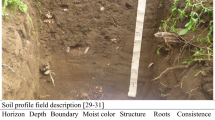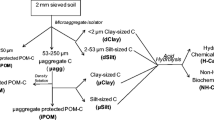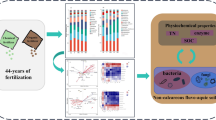Abstract
The effects of mineral fertilizer (NPK) and organic manure on phospholipid fatty acid profiles and microbial functional diversity were investigated in a long-term (21-year) fertilizer experiment. The experiment included nine treatments: organic manure (OM), organic manure plus fertilizer NPK (OM + NPK), fertilizer NPK (NPK), fertilizer NP (NP), fertilizer NK (NK), fertilizer N (N), fertilizer P (P), fertilizer K (K), and the control (CK, without fertilization). The original soil was extremely eroded, characterized by low pH and deficiencies of nutrients, particularly N and P. The application of OM and OM + NPK greatly increased crop yields, soil pH, organic C, total N, P and K, available N, P and K content. Crop yields, soil pH, organic C, total N and available N were also clearly increased by the application of mineral NPK fertilizer. The amounts of total PLFAs, bacterial, Gram-negative and actinobacterial PLFAs were highest in the OM + NPK treatment, followed by the OM treatment, whilst least in the N treatment. The amounts of Gram-positive and anaerobic PLFAs were highest in the OM treatment whilst least in the P treatment and the control, respectively. The amounts of aerobic and fungal PLFAs were highest in the NPK treatment whilst least in the N and P treatment, respectively. The average well color development (AWCD) was significantly increased by the application of OM and OM + NPK, and the functional diversity indices including Shannon index (H ′), Simpson index (D) and McIntosh index (U) were also significantly increased by the application of OM and OM + NPK. Principal component analysis (PCA) of PLFA profiles and C source utilization patterns were used to describe changes in microbial biomass and metabolic fingerprints from nine fertilizer treatments. The PLFA profiles from OM, OM + NPK, NP and NPK were significantly different from that of CK, N, P, K and NK, and C source utilization patterns from OM and OM + NPK were clearly different from organic manure deficient treatments (CK, N, P, K, NP, NK 6 and NPK). Stepwise multiple regression analysis showed that total N, available P and soil pH significantly affected PLFA profiles and microbial functional diversity. Our results could provide a better understanding of the importance of organic manure plus balanced fertilization with N, P and K in promoting the soil microbial biomass, activity and diversity and thus enhancing crop growth and production.


Similar content being viewed by others
References
Acton DF, Gregorich LJ (1995) The health of our soils: toward sustainable agriculture in Canada. Agriculture Agri-Food Canada, CDR Unit, Ottawa
Anderson TH (2003) Microbial eco-physiological indicators to asses soil quality. Agric Ecosyst Environ 98:285–293. doi:10.1016/S0167-8809(03)00088-4
Belay A, Claassens AS, Wehner FC (2002) Effect of direct nitrogen and potassium and residual phosphorus fertilizers on soil chemical properties, microbial components and maize yield under long-term crop rotation. Biol Fertil Soils 35:420–427. doi:10.1007/s00374-002-0489-x
Bending GD, Turner MK, Rayns F, Marx MC, Wood M (2004) Microbial and biochemical soil quality indicators and their potential for differentiating areas under contrasting agricultural management regimes. Soil Biol Biochem 36:1785–1792. doi:10.1016/j.soilbio.2004.04.035
Bligh EG, Dyer WJ (1959) A rapid method of total lipid extraction and purification. Can J Biochem Physiol 37:911–917
Borga P, Nilsson M, Tunlid A (1994) Bacterial communities in peat in relation to botanical composition as revealed by phospholipid fatty acid analysis. Soil Biol Biochem 7:841–848. doi:10.1016/0038-0717(94)90300-X
Bossio DA, Scow KM, Gunapala N, Graham KJ (1998) Determinants of soil microbial communities: Effects of agricultural management, season, and soil type on phospholipid fatty acid profiles. Microb Ecol 36:1–12. doi:10.1007/s002489900087
Brant JB, Sulzman EW, Myrold DD (2006) Microbial community utilization of added carbon substrates in response to long-term carbon input manipulation. Soil Biol Biochem 38:2219–2232. doi:10.1016/j.soilbio.2006.01.022
Cai ZC, Qin SW (2006) Dynamics of crop yields and soil organic carbon in a long-term fertilization experiment in the Huang-Huai-Hai Plain of China. Geoderma 136:708–715. doi:10.1016/j.geoderma.2006.05.008
Campbell CD, Grayston SJ, Hirst DJ (1997) Use of rhizosphere carbon sources in sole carbon source tests to discriminate soil microbial communities. J Microbiol Methods 30:33–41. doi:10.1016/S0167-7012(97)00041-9
Chu HY, Fujii T, Morimoto S, Lin XG, Yagi K, Hu JL, Zhang JB (2007) Community structure of ammonia-oxidizing bacteria under long-term application of mineral fertilizer and organic manure in a sandy loam soil. Appl Environ Microbiol 73:485–491. doi:10.1128/AEM.01536-06
Demoling F, Nilsson LO, Bååth E (2008) Bacterial and fungal response to nitrogen fertilization in three coniferous forest soils. Soil Biol Biochem 40:370–379. doi:10.1016/j.soilbio.2007.08.019
Doran JW, Zeiss MR (2000) Soil health and sustainability: managing the biotic component of soil quality. Appl Soil Ecol 15:3–11. doi:10.1016/S0929-1393(00)00067-6
Elo S, Maunuksela L, Salkinoja-Salonen M, Smolander A, Haahtela K (2000) Humus bacteria of Norway spruce stands: plant growth promoting properties and birch, red fescue and alder colonizing capacity. FEMS Microbiol Ecol 31:143–152. doi:10.1111/j.1574-6941.2000.tb00679.x
Garbeva P, Van Veen JA, Van Elsas JD (2004) Microbial diversity in soil: selection of microbial populations by plant and soil type and implications for soil suppressiveness. Annu Rev Phytopathol 42:243–270. doi:10.1146/annurev.phyto.42.012604.135455
Garland JL (1997) Analysis and interpretation of community-level physiological profiles in microbial ecology. FEMS Microbiol Ecol 24:289–300. doi:10.1111/j.1574-6941.1997.tb00446.x
Garland JL, Mills AL (1991) Classification and characterization of heterotrophic microbial communities on the basis of patterns of community-level-sole-carbon-source-utilization. Appl Environ Microbiol 57:2351–2359
Grønli KE, Frostegård Å, Bakken LR, Ohlson M (2005) Nutrient and carbon additions to the microbial soil community and its impact on tree seedlings in a boreal spruce forest. Plant Soil 278:275–291. doi:10.1007/s11104-005-8765-9
He JZ, Shen JP, Zhang LM, Zhu YG, Zheng YM, Xu MG, Di HJ (2007) Quantitative analyses of the abundance and composition of ammonia-oxidizing bacteria and ammonia-oxidizing archaea of a Chinese upland red soil under long-term fertilization practices. Environ Microbiol 9:2364–2374. doi:10.1111/j.1462-2920.2007.01358.x
He JZ, Zheng Y, Chen CR, He YQ, Zhang LM (2008) Microbial composition and diversity of an upland red soil under long-term fertilization treatments as revealed by culture-dependent and culture-independent approaches. J Soils Sediments 8:349–358. doi:10.1007/s11368-008-0025-1
Karlen DL, Mausbach MJ, Doran JW, Cline RG, Harris RF, Schuman GE (1997) Soil quality: a concept, definition, and framework for evaluation. Soil Sci Soc Am J 61:4–10
Kennedy AC, Smith KL (1995) Soil microbial diversity and the sustainability of agricultural soils. Plant Soil 170:75–86. doi:10.1007/BF02183056
Kourtev P, Ehrenfeld J, Häggblom M (2002) Exotic plant species alter the microbial community structure and function in the soil. Ecology 83:3152–3166
Kourtev P, Ehrenfeld J, Häggblom M (2003) Experimental analysis of the effect of exotic and native plant species on the structure and function of soil microbial communities. Soil Biol Biochem 35:895–905. doi:10.1016/S0038-0717(03)00120-2
Lou YS, Li ZP, Zhang TL, Liang YC (2004) CO2 emissions from subtropical arable soils of China. Soil Biol Biochem 36:1835–1842. doi:10.1016/j.soilbio.2004.05.006
Mallarino AP, Borges R (2006) Phosphorus and potassium distribution in soil following long-term deep-band fertilization in different tillage systems. Soil Sci Soc Am J 70:702–707. doi:10.2136/sssaj2005.0129
McAndrew DW, Malhi SS (1992) Long-term N fertilization of a solonetzic soil: effects on chemical and biological properties. Soil Biol Biochem 24:619–623. doi:10.1016/0038-0717(92)90039-Z
Mele PM, Crowley DE (2008) Application of self-organizing maps for assessing soil biological quality. Agric Ecosyst Environ 126:139–152. doi:10.1016/j.agee.2007.12.008
Paul EA (2007) Soil microbiology, ecology, and biochemistry , 3rd edn. Academic Press, San Diego, USA, p 532
Pernes-Debuyers A, Tessier D (2004) Soil physical properties affected by long-term fertilization. Eur J Soil Sci 55:505–512. doi:10.1111/j.1365-2389.2004.00614.x
Potthoff M, Steenwerth KL, Jackson LE, Drenovsky RE, Scow KM, Joergensen RG (2006) Soil microbial community composition as affected by restoration practices in California grassland. Soil Biol Biochem 38:1851–1860. doi:10.1016/j.soilbio.2005.12.009
Robson AD (1989) Soil acidity and plant growth. Academic press, Sydney
Saetre P, Bååth E (2000) Spatial variation and patterns of soil microbial community structure in a mixed spruce-birch stand. Soil Biol Biochem 32:909–917. doi:10.1016/S0038-0717(99)00215-1
Sarathchandra SU, Ghani A, Yeates GW, Burch G, Cox NR (2001) Effect of nitrogen and phosphate fertilisers on microbial and nematode diversity in pasture soils. Soil Biol Biochem 33:953–964. doi:10.1016/S0038-0717(00)00245-5
Shen WS, Lin XG, Gao N, Zhang HY, Yin R, Shi WM, Duan ZQ (2008) Land use intensification affects soil microbial populations, functional diversity and related suppressiveness of cucumber Fusarium wilt in China’s Yangtze River Delta. Plant Soil 306:117–127. doi:10.1007/s11104-007-9472-5
Söderberg KH, Probanza A, Jumpponen A, Bååth E (2004) The microbial community in the rhizosphere determined by community-level physiological profiles (CLPP) and direct soil- and cfu-PLFA techniques. Appl Soil Ecol 25:135–145. doi:10.1016/j.apsoil.2003.08.005
Sparling GP (1997) Soil microbial biomass, activity and nutrient cycling as indicators of soil health. In: Pankhurst CE, Doube BM, Gupta VVSR (eds) Biological indicators of soil health. CAB International, pp, pp 97–119
Steenwerth KL, Jackson LE, Calderón FJ, Stromberg MR, Scow KM (2002) Soil microbial community composition and land use history in cultivated and grassland ecosystems of coastal California. Soil Biol Biochem 34:1599–1611. doi:10.1016/S0038-0717(02)00144-X
Visser S, Parkinson D (1992) Soil biological criteria as indicators of soil quality: Soil microorganisms. Am J Altern Agric 7:33–37
Waldrop MP, Zak DR, Sinsabaugh RL (2004) Microbial community response to nitrogen deposition in northern forest ecosystems. Soil Biol Biochem 36:1443–1451. doi:10.1016/j.soilbio.2004.04.023
Zak JC, Willig MR, Moorhead DL, Wildman HG (1994) Functional diversity of microbial communities: a quantitive approach. Soil Biol Biochem 26:1101–1108. doi:10.1016/0038-0717(94)90131-7
Zelles L, Bai QY, Rackwitz R, Chadwick D, Beese F (1995) Determination of phospholipid- and lipopolysaccharide-derived fatty acids as an estimate of microbial biomass and community compositions in soils. Biol Fertil Soils 19:115–123. doi:10.1007/BF00336146
Zhao QG (2002) Mechanism, Temporal-Spatial Changes and Controlling Countermeasures of Soil Degradation in Hilly Red Soil Region of Southeastern China. Science Press, Beijing, China, pp 290–332
Zhong WH, Cai ZC (2007) Long-term effects of inorganic fertilizers on microbial biomass and community functional diversity in a paddy soil derived from quaternary red clay. Appl Soil Ecol 36:84–91. doi:10.1016/j.apsoil.2006.12.001
Zhong WH, Cai ZC, Zhang H (2007) Effects of long-term application of inorganic fertilizers on biochemical properties of a rice-planting red soil. Pedosphere 17:419–428. doi:10.1016/S1002-0160(07)60051-4
Acknowledgements
This work was supported by a Knowledge Innovation Project of the Chinese Academy of Sciences (No. Kzcx2-yw-408) and the National Natural Science Foundation of China (No. 40830531). The authors thank two anonymous reviewers for their valuable comments and suggestions that had improved this manuscript greatly.
Author information
Authors and Affiliations
Corresponding author
Additional information
Responsible editor: Petra Marschner.
An erratum to this article can be found at http://dx.doi.org/10.1007/s11104-009-0099-6
Rights and permissions
About this article
Cite this article
Zhong, W., Gu, T., Wang, W. et al. The effects of mineral fertilizer and organic manure on soil microbial community and diversity. Plant Soil 326, 511–522 (2010). https://doi.org/10.1007/s11104-009-9988-y
Received:
Accepted:
Published:
Issue Date:
DOI: https://doi.org/10.1007/s11104-009-9988-y




